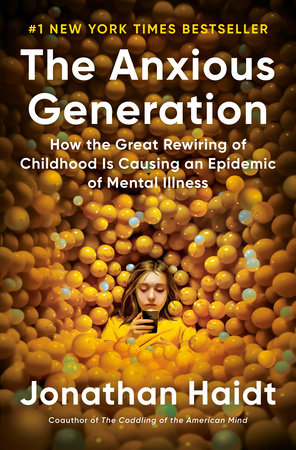I don’t have time to read…I’m not anxious…My children aren’t anxious…I don’t have teenagers yet…I don’t believe in “anxiety”…I’m not Generation Z…I’m not a parent of a teen with a phone…The author is not a Christian…I don’t like numbers and statistics…Thinking of these things makes me upset…What can I even do about it?
Should I read The Anxious Generation? Again, yes.
In his book The Anxious Generation, just published in March of this year, Jonathan Haidt continues his research on the American mind. Social psychologist and author, Haidt has provoked the public to think about the use of the technology residing in nearly the pocket of nearly every one of us, safe-spaces and mental illness are intertwined in our nation’s educational system. Although the data suggests a higher impact of the lack of play, risk-taking, and challenge on children and youth, when one part of our country suffers, we all suffer. Just as in 1 Corinthians 12 we are given the imagery of the body with its many members of great value, in verse 26 Paul writes, “If one member suffers, all suffer together.” Therefore, when our nation’s young adults, teens, and youths are suffering with, as Haidt’s research tells us, a 135% increase in depression in girls and a 161% increase in boys since 2010, we are all suffering. If you are not of the “anxious generation,” your son is, your daughter is, your sister is, your brother is, your neighbor is, your co-worker is, your friend in church small group is. And when one part of the body suffers, we all suffer together.
The issues Haidt addresses affect us all, and the solutions require us all. While the data, statistics, and personal stories can call to mind a sense of deep concern, helplessness, or hopelessness, Part 4 of his book is titled, “Collective Action for Healthier Childhood,” and it is here that we find our next steps. Delay the age that children get smartphones and social media. It’s not too late. With the metaphor of turning a plane back around when a safety issue is discovered, “we can change it if we want to,” Haidt proclaims in Chapter 9. When the smartphone landed on planet earth, it changed us all. “In 2010, there was little sign of a mental health crisis, and now, it’s all around us” (Haidt, Ch 9). We must move from phone-based, to play-based childhood. Governments, Schools, and Parents can make this a reality. Phone-free schools, more free play, screen-free family meals and outings, are just some of the ways we can impact our children’s social development for the better.
Haidt addresses in his book age-based actions we can take as parents because building a better childhood requires different actions for a 2-year-old and a 12-year-old. While in my household, our children (8, 5, and 8 months old) don’t have cell phones and we haven’t yet approached these conversations, that doesn’t mean these calls to action don’t apply. One way we have challenged this in our family is seeking opportunities to let our children be free. Our 8-year-old walks the dog around the neighborhood by herself and has gone into our local, familiar grocery store with a short list and a pocketful of cash. The joy on her face when she walked back to the car, shopping bag and receipt in hand far exceeded the blip of “happiness” a child has when seeing a new episode of a favorite cartoon. While she returned with the items on the list and an extra box of chocolates, even that experience was paramount in her sense of responsibility, developing her maturity, and provided a math practice as she calculated whether the pocket cash she carried was enough to cover that extra box of chocolates.

Meet the Author:
Megan Soper is a mom of 3 and a beloved member of our Upper School Faculty teaching 6th grade math and latin in addition to Rhetoric to 9th and 10th grade.


